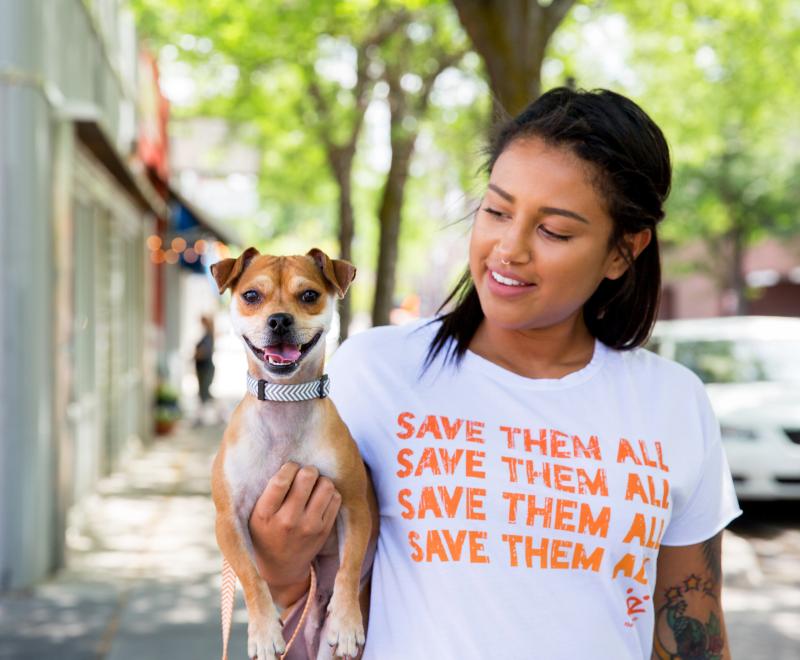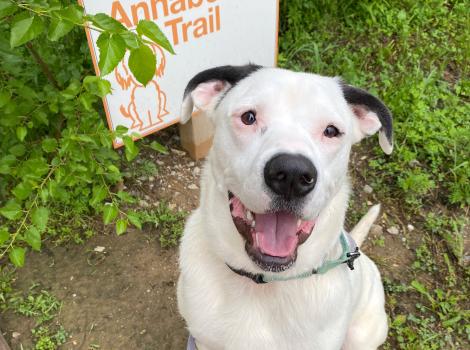Busting myths about fostering dogs

Foster volunteers are the unsung heroes of animal rescue. Without their dedication, more dogs and cats would lose their lives in America’s shelters. And despite tremendous progress, hundreds of thousands of pets — 415,000 in 2023 alone — are still being killed in shelters every year, simply because they lack a safe place to call home.
Our nation’s pets deserve homes, not shelters. Fostering is a great way to help them get there, even if you aren’t looking to adopt a pet right now. If you’ve considered fostering but felt hesitant, we get it. Let’s explore — and hopefully dispel — a few myths about this rewarding experience.
Why fostering matters
“We get bombarded with pleas for help, and sometimes we simply don’t have space for all of the animals,” says Jamie Clark, director of operations at Acadiana Animal Aid (AAA) in Carencro, Louisiana, pointing to a recent hoarding case in which AAA had 24 hours to create space for 23 dogs. “If we didn’t have enough fosters step up to help, we would have had to say no.”
Pima Animal Care Center (PACC) in Tucson, Arizona, is an open-admission shelter, which means it has to accept every animal. In 2023, PACC took in 17,081 animals, adopting out over 10,000 of them. One reason for the shelter’s success? Its robust foster program.
[Foster home is simply the best for mama dog and pups]
At any given time, PACC has 700 to 1,500 animals in foster care. “Fostering literally saves these lives,” says Kayleigh Murdock, PACC’s public information officer. Placing a pet in foster care opens up space for another animal to come into the shelter. “I can’t stress enough how short we are on kennel space, and having an animal go into a home, even for a short time, can help with overcrowding issues,” Kayleigh says.
So the result of fostering is undeniable: Lives are saved. And whatever hesitations you might be having about fostering, you can take comfort in knowing there’s a huge community of foster volunteers who’ve overcome their own hesitations.

Positive impact of fostering on pets
Let’s talk about one of the apprehensions you might be having. If you’re concerned about the psychological impact on a pet taken out of the shelter system, only to be returned to the shelter after the fostering period is finished, you’re not alone. In other words, can fostering be harmful to a pet’s well-being?
In fact, time in a home (yours, perhaps?) can do the opposite, providing a calm place for a pet to relax and decompress. The shelter environment can be stressful. “If we can get dogs away (from the shelter) long enough, we see a different dog when they come back to the shelter,” Jamie says.
The quiet, stable atmosphere of a home is also preferable for cats, even if it’s short term. The noisy and unpredictable shelter environment makes it difficult for cats to demonstrate their true personalities and contributes to the development of health problems.
[Magnanimous dog blossoms in foster care]
A pet’s time in foster care can mean anything from an overnight to several weeks to a commitment to foster until the animal is adopted. At AAA, for instance, foster volunteers commit to a minimum of two weeks. “People have an easier time stepping up to foster when there’s a time limit,” Jamie says, but she adds that it’s not uncommon for volunteers to become so invested in a dog’s future that they continue fostering until the dog is adopted.
Even a short stint in a foster home can be beneficial. When researchers studied the effects of one- and two-night fostering on dogs from shelters, they found that the dogs’ levels of the stress hormone cortisol were significantly reduced. Dogs also commonly suffer sleep deficiency in shelters, but in foster homes they got more sleep, even snoozing more in the shelter after their sleepovers, according to a study in the journal Zoological Science.
Consider, too, that dogs with medical issues need a quiet environment to recover. “Illness and injury don’t resolve as quickly in the shelter as they do in a home,” Jamie explains.

Improving pets’ adoption prospects
When PACC was undergoing construction and needed to clear 100 kennels for two weeks, foster volunteers were asked to house those animals during that time. “Within the first week of coming back to the shelter, about 15% of those dogs were adopted,” says Katie Hutchinson, PACC animal placement manager.
The same holds true for dogs who are traditionally overlooked in shelters. That’s because foster volunteers learn a lot about the dogs (e.g., whether the dog is house-trained, how she does in a crate, what activities he enjoys) and can share photos and stories that help potential adopters imagine these dogs living in their home. Take, for instance, Big Bird, a doodle mix at AAA who was reactive and barked constantly in the shelter. Because no adopter was looking at him, he went into foster care. After his foster volunteers reported that he was actually easygoing and great with kids, Big Bird was adopted.

Fostering doesn’t just increase dogs’ odds of adoption but also the chances that they will stay in their new homes. “Animals who go through foster care prior to adoption have a lower return rate,” Jamie says. “Because we have more information on that dog, we’re able to make stronger placements.”
In addition, when volunteers take their foster dogs out into the community, perhaps walking them around the neighborhood or in a park, that’s instant marketing for these dogs. “Many people have a misconception that shelter pets are broken,” says Katie. Seeing foster dogs in public helps change people’s minds and may attract potential adopters.
The financial commitment
“We want to make fostering an option for everybody,” says Katie Howerton, AAA’s foster coordinator. And she knows that means removing as many obstacles — or perceptions of false ones — as possible, including what people perceive to be a financial commitment involved in fostering.
The reality? Most foster programs provide everything you need, including litter, toys, food, baby gates, crates, potty pads, and medications. Veterinary care is also covered. Some shelters like AAA even have a veterinary clinic and can call on volunteers to help transport animals to and from appointments.
Getting too attached to foster pets
Undoubtedly, though, the biggest obstacle holding people back is fear that they’ll get too attached to the animal to give him or her up. “The reward is knowing what you did for that animal and how much you changed that animal’s life,” says Kayleigh, who cries every time a foster pet leaves.
Courtney Butler, a foster volunteer in Fort Wayne, Indiana, agrees that the reward is real. Along with her husband Jake and son LJ, Courtney has fostered 212 dog moms and puppies since 2014 through organizations such as Humane Fort Wayne and the Fort Wayne Pit Bull Coalition. “Once you see the photos of your foster pets in their new homes and realize that you’ve been the link to that connection, you feel completely validated,” she says.

Yet Courtney doesn’t think letting go is as tough as most people think it is, especially if you’re fostering puppies. “By the time they’re 7 weeks old, you’ll probably be calling the shelter asking to take them back,” she says with a laugh.
Once the dogs are ready to be adopted, the Butlers typically return them to the shelter to give them more exposure to potential adopters. Although it can be emotional to return your foster pet, remember one important point: “You’ve set those animals up for an incredible path out of the shelter,” Kayleigh says.
Fostering while working away from home
Jessie Ng, who lives in the Quad Cities area in Illinois and who works from home, began fostering in 2019 so she could get to know a dog before adopting. (One perk of fostering is that volunteers often get first dibs on adopting their foster pet.) Sure enough, that first foster pet proved to be such a good fit that Jessie adopted her. Since then, Jessie has fostered 36 more pets through various rescue groups, including It Takes a Village Animal Rescue and Resources in Muscatine, Iowa, and all of them have stayed with her until they were adopted.

You may be thinking, sure, working from home makes it so much easier. What about fostering for those of us who work away from home? Kayleigh says, “An animal who’s home for nine hours while you’re at work will still have more interaction and love than they would get in a shelter.” In fact, certain pets — like those who are fearful, shy, or shut down — might even appreciate lounging around a quiet house while you’re at work. (Wait. Did we just bust another myth?)
Other rewards
The people who open their homes to foster pets reap rewards beyond knowing that they’ve helped save a life. For instance, as Jessie says: “I get to meet like-minded people, and my best friends here have all been people I met through fostering.” For Courtney, fostering has helped her heal from her prior work in a high-volume shelter, and it’s something she can do with her family. And for other folks, fostering allows them to have an animal in their lives when adoption isn’t an option.
The need for foster volunteers has never been greater. This year, roughly 7 million households in America plan to welcome a new pet. If just 6% more of those people choose to adopt, we would end the killing of pets in our nation’s shelters. Fostering plays a significant role in increasing pets’ chances of survival and adoption.
If you’ve been thinking about bringing a pet from the shelter into your home temporarily but haven’t yet taken the plunge, remember what Jamie says: “Fostering is a short-term commitment to help us solve a long-term problem, as we can’t rescue our way out of this.” Simply put, we need more foster volunteers prepared to kick the myths to the curb.

This article was originally published in the September/October 2024 issue of Best Friends magazine. Want more good news? Become a member and get stories like this six times a year.
Let's make every shelter and every community no-kill in 2025
Our goal at Best Friends is to support all animal shelters in the U.S. in reaching no-kill in 2025. No-kill means saving every dog and cat in a shelter who can be saved, accounting for community safety and good quality of life for pets.
Shelter staff can’t do it alone. Saving animals in shelters is everyone’s responsibility, and it takes support and participation from the community. No-kill is possible when we work together thoughtfully, honestly, and collaboratively.







